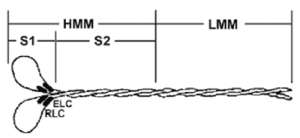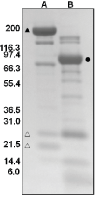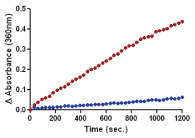Myosin - skeletal muscle S1 fragment
* Limited stock available. If stock is not available, Cytoskeleton will produce a new batch upon request. Minimum order will apply. Inquire for more information.
Product Uses
- Measurement of F-actin activated myosin ATPase activity
- Identification/characterization of proteins or small molecules that affect myosin ATPase activity
- Identification/characterization of proteins or small molecules that affect myosin / F- actin interaction
Materials
Skeletal muscle myosin protein has been purified from rabbit psoas muscle (1, 2). The full length myosin protein was purified with its essential light chains (ELC) and regulatory light chains (RLC), see Figure 1 and 2. Myosin was then digested with alpha-chymotrypsin to liberate the soluble subfragment-1 (S1) domain, which was isolated by centrifugation (3). The purified myosin S1 fragment has been determined to be biologically active in an Factin activated ATPase assay (see biological activity assay). Rabbit psoas myosin S1 fragment protein is supplied as a white lyophilized powder.
Figure 1. Diagrammatic representation of the myosin protein and its subfragments

Legend: Myosin is a hexameric protein consisting of two heavy chains and two light chains. Myosin can be proteolytically cleaved into heavy meromyosin (HMM) and light meromyosin (LMM) by α-chymotrypsin in the presence of magnesium. In the presence of EDTA, however, α-chymotrypsin produces the soluble myosin S1 fragment (3).
Storage and Resonstitution
Briefly centrifuge to collect the product at the bottom of the tube. Reconstituting a tube of MYS04 with 75 ul of Milli-Q water will generate a 3.3 mg/ml stock of psoas S1 myosin in the following buffer: 20 mM PIPES pH 7.0, 1 mM EDTA, 5% (w/v) sucrose and 1% (w/v) dextran. The protein should not be exposed to repeated freeze-thaw cycles. The lyophilized protein is stable at 4°C desiccated(<10% humidity) for 1 year.
Purity
Protein purity is determined by scanning densitometry of Coomassie Blue stained protein on a 4-20% gradient polyacrylamide gel. The myosin and its light chains used to produce the myosin S1 fragment was determined to be 90% pure (see Figure2).
Figure 2. Full length and S1 myosin
.

A 20 μg sample of full length rabbit psoas myosin protein (lane A) and the corresponding S1 myosin (lane B) were separated by electrophoresis using a 4-20% SDS-PAGE gel and stained with Coomassie Blue. The closed triangle indicates the myosin heavy chain (approx. 200 kDa), open triangles indicate the RLC (approx. 20 kDa) and two ELC isoforms (approx. 25 and 21 kDa), and the S1 fragment (approx. 97 kDa) is indicated with a closed circle. Protein quantitation was performed using the Precision Red™ Protein Assay Reagent (Cat.# ADV02). Mark12 molecular weight markers are from Invitrogen.
Biological Activity Assay
The biological activity of rabbit psoas myosin S1 fragment can be determined from its rate of F-actin activated ATP hydrolysis. The assay is constructed by first polymerizing actin to form F-actin, then the cardiac tropomyosin/troponin complex (TT complex) is mixed with the actin filaments in a stoichiometric amount. This creates coated filaments which are analogous to the thin filaments of muscle fibers. Myosin is added in substoichiometric amounts and the reaction initiated with ATP and calcium. Stringent quality control ensures that in the absence of calcium the TT complex completely inhibits myosin ATPase. Upon addition of 2 mM calcium, myosin ATPase will be restored (see Figure 3). Calcium binds to Troponin C which dissociates from F-actin allowing myosin to bind.
Reagents
1. Cardiac TT complex (0.5 mg, # CS-TT05)
2. Psoas S1 Myosin (1 mg, # CS-MYS04)
3. Cardiac Actin (1 mg, # CS-ADMK)
4. ATPase Assay Biochem Kit (Cat. # BK051)
5. 100 mM ATP in 50 mM Tris-HCl pH 7.5
6. PM12 Buffer (12 mM Pipes-KOH, pH 7.0, 2 mM MgCl2).
7. 500 mM EGTA-Na, pH 8.0.
Equipment
1. Spectrophotometer capable of measuring absorbance at 360 nm (+/- 5 nm bandwidth). We recommend a Spectra-Max M2 (Molecular Devices), filter based machines are not suitable.
2. Half area 96 well microtiter plate (Corning Cat.# 3696 or 3697)
3. Multi-channel pipette
Method
The following major steps are recognized:
Step 1. Assemble required reagents and compounds. (30min). Only if screening.
Step 2. Prepare F-actin polymer stock. (2h).
Step 3. Prepare Motor Mix and plate reader. (15min).
Step 4. Pipette Motor Mix into wells and start reaction/plate reader. (10min).
F-actin polymer stock
1. Resuspend ADMK or AD99 with 2.5 ml of Buffer to 0.4 mg/ml, Buffer is 5mM Pipes-KOH, 100 uM ATP, 500uM DTT.
2. Place at RT for 30 min to depolymerize the actin oligos that form during concentration/lyophilization.
3. Then add 2 mM MgCl2 and 2 mM EGTA and incubate at RT for 1 h to polymerize. (shelf life 1h at RT).
Myosin ATPase assay
1. Dilute S1 myosin to 1 mg/ml with ice cold PM12 Buffer.
2. Resuspend TT05 on ice with ice cold water to 5mg/ml. (100 μl per vial for 0.5 mg vial).
3. Mix the following to make 1 ml of actin/TT/myosin (ATM) control mixture:
150 μl of F-actin (0.4 mg/ml in 5mM Pipes pH 7.5, 2 mM MgCl2, 58 μM CaCl2, 2 mM EGTA, 100 μM ATP, 500 μM DTT)
100 μl of TT05
80 μl of PM12 Buffer
100 μl 5x MSEG
5 μl of 100x PNP
4. Wait for 10 min to make thin filaments.
5. Add 2.5 μl of S1 myosin and 5 ul of 50 mM ATP and mix.
6. Incubate at 37°C for 3 min.
7. Using the pre-warmed half area 96-well plate, pipette the following:
8. Pipette 10 μl of 2 mM calcium into “activated” wells.
9. Pipette 10 μl of Milli-Q water into “non-activated” wells.
11. Pipette 90 μl of myosin/TT/actin mixture into all wells.
12. Start protocol, 41 readings, 30 seconds apart, 37°C , OD 360nm.
13. Calculate Vmax and compare non-activated to calcium activated samples.

Figure 3: Absorbance traces for the ATPase assay of MYS04
Representative data for the ATPase assay described in the Biological Activity Assay section using 2.5 ug/ml MYS04 in the presence (red circles) or absence (blue circles) of 200 uM CaCl2.
References
1. Pollard, T.D., . 1982. Methods in Cell Biol. 24:333
2. Margossian, S.S., and Lowey, S. 1982. Methods in Enzymology.85:55-71.
3. Weeds, A.G., and Taylor, R.S. 1975. Nature (London) 257:54.
For product Datasheets and MSDSs please click on the PDF links below.
Coming soon! If you have any questions concerning this product, please contact our Technical Service department at tservice@cytoskeleton.com
